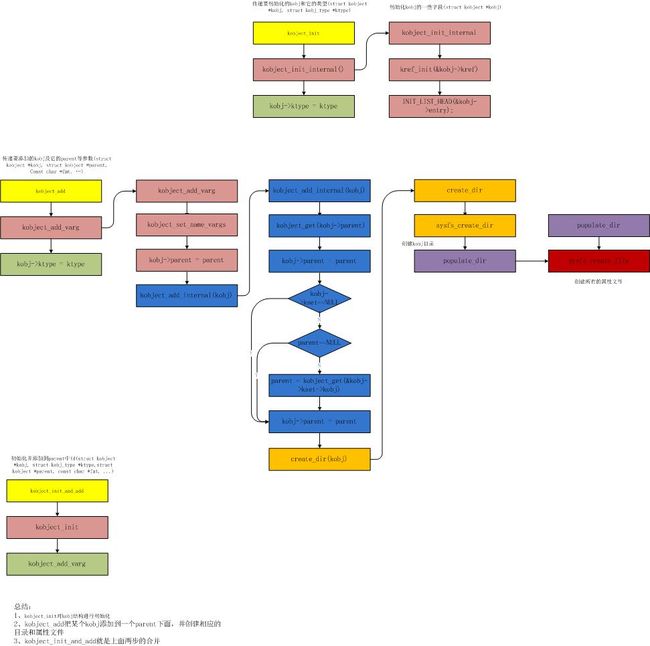linux设备驱动模型一三基础结构之Kobject
在linux的驱动表示中,主要有三个基本的结构,分别是kobject,kset,ktype.Kobject,kset,kypte这三个结构是设备模型中的下层架构。模型中的每一个元素都对应一个kobject.kset和ktype可以看成是kobject在层次结构与属性结构方面的扩充。将三者之间的关系用图的方示描述如下:
如上图所示:我们知道。在sysfs中每一个目录都对应一个kobject.这些kobject都有自己的parent。在没有指定parent的情况下,都会指向它所属的kset->object。其次,kset也内嵌了kobject.这个kobject又可以指它上一级的parent。就这样。构成了一个空间上面的层次关系。
其实,每个对象都有属性。例如,电源管理,执插拨事性管理等等。因为大部份的同类设备都有相同的属性,因此将这个属性隔离开来,存放在ktype中。这样就可以灵活的管理了.记得在分析sysfs的时候。对于sysfs中的普通文件读写操作都是由kobject->ktype->sysfs_ops来完成的.
kobject
struct kobject {
const char *name; //名字
struct list_head entry; //连接到kset建立层次结构
struct kobject *parent; //指向父节点,面向对象的层次架构
struct kset *kset; //指向所属的kset
struct kobj_type *ktype; //属性文件
struct sysfs_dirent *sd;
struct kref kref; //引用计数
unsigned int state_initialized:1; //初始化状态...
unsigned int state_in_sysfs:1;
unsigned int state_add_uevent_sent:1;
unsigned int state_remove_uevent_sent:1;
unsigned int uevent_suppress:1;
};
在Linux内核里,kobject是组成Linux设备模型的基础,一个kobject对应sysfs里的一个目录。从面向对象的角度来说,kobject可以看作是所有设备对象的基类,因为C语言并没有面向对象的语法,所以一般是把kobject内嵌到其他结构体里来实现类似的作用,这里的其他结构体可以看作是kobject的派生类。Kobject为Linux设备模型提供了很多有用的功能,比如引用计数,接口抽象,父子关系等等,所以,在内核中,没有用kobject直接定义的变量,kobject只是作为一个抽象的基类而存在。一般都是将kobject嵌入到另一个结构,这个结构就可以看做是kobject的一个子类。而kobject的子类会比较关心kobject的属性和方法。
内核里的设备之间是以树状形式组织的,在这种组织架构里比较靠上层的节点可以看作是下层节点的父节点,反映到sysfs里就是上级目录和下级目录之间的关系,在内核里,正是kobject帮助我们实现这种父子关系。在kobject的定义里,name表示的是kobject在sysfs中的名字;指针parent用来指向kobject的父对象;Kref大家应该比较熟悉了,kobject通过它来实现引用计数;Kset指针用来指向这个kobject所属的kset;对于ktype,如果只是望文生义的话,应该是用来描述kobject的类型信息。
struct kref//引用计数
{
atomic_t refcount;
}
kobject的作用:
1、sysfs 表述:在 sysfs 中出现的每个对象都对应一个 kobject, 它和内核交互来创建它的可见表述。
2、数据结构关联:整体来看, 设备模型是一个极端复杂的数据结构,通过其间的大量链接而构成一个多层次的体系结构。kobject 实现了该结构并将其聚合在一起。
3、热插拔事件处理 :kobject 子系统将产生的热插拔事件通知用户空间。
一个kobject对自身并不感兴趣,它存在的意义在于把高级对象连接到设备模型上。因此内核代码很少(甚至不知道)创建一个单独的 kobject;而kobject 被用来控制对大型域(domain)相关对象的访问,所以kobject 被嵌入到其他结构中。kobject 可被看作一个最顶层的基类,其他类都它的派生产物。 kobject 实现了一系列方法,对自身并没有特殊作用,而对其他对象却非常有效。
对于给定的kobject指针,可使用container_of宏得到包含它的结构体的指针
1、初始化---kobject_init
void kobject_init(struct kobject *kobj, struct kobj_type *ktype)
{
char *err_str;
if (!kobj) {
err_str = "invalid kobject pointer!";
goto error;
}
if (!ktype) {
err_str = "must have a ktype to be initialized properly!\n";
goto error;
}
if (kobj->state_initialized) {
/* do not error out as sometimes we can recover */
printk(KERN_ERR "kobject (%p): tried to init an initialized "
"object, something is seriously wrong.\n", kobj);
dump_stack();
}
kobject_init_internal(kobj);//进行主要的成员变量初始化
kobj->ktype = ktype; //关联这个kobject类型
return;
error:
printk(KERN_ERR "kobject (%p): %s\n", kobj, err_str);
dump_stack();
}
static void kobject_init_internal(struct kobject *kobj)
{
if (!kobj)
return;
kref_init(&kobj->kref);//初始化引用计数为1
INIT_LIST_HEAD(&kobj->entry);//prev和next都指向自己
kobj->state_in_sysfs = 0;
kobj->state_add_uevent_sent = 0;
kobj->state_remove_uevent_sent = 0;
kobj->state_initialized = 1;
}
2、将kobject加入到分层结构-----kobject_add
*/
int kobject_add(struct kobject *kobj, struct kobject *parent,
const char *fmt, ...)
{
va_list args;
int retval;
if (!kobj)
return -EINVAL;
if (!kobj->state_initialized) {
printk(KERN_ERR "kobject '%s' (%p): tried to add an "
"uninitialized object, something is seriously wrong.\n",
kobject_name(kobj), kobj);
dump_stack();
return -EINVAL;
}
va_start(args, fmt);
retval = kobject_add_varg(kobj, parent, fmt, args);//主要的add操作
va_end(args);
return retval;
}kobject_add_varg():
static int kobject_add_varg(struct kobject *kobj, struct kobject *parent,
const char *fmt, va_list vargs)
{
int retval;
retval = kobject_set_name_vargs(kobj, fmt, vargs);//设置kobject的名字。即kobject的name成员
if (retval) {
printk(KERN_ERR "kobject: can not set name properly!\n");
return retval;
}
kobj->parent = parent; //设置kobject的parent
return kobject_add_internal(kobj);//在sysfs中添加kobjcet信息
}
static int kobject_add_internal(struct kobject *kobj)
{
int error = 0;
struct kobject *parent;
if (!kobj)
return -ENOENT;
if (!kobj->name || !kobj->name[0]) { //如果kobject的名字为空.退出
WARN(1, "kobject: (%p): attempted to be registered with empty "
"name!\n", kobj);
return -EINVAL;
}
parent = kobject_get(kobj->parent);//如果parent为真,则增加kobj->kref计数,也就是父节点的引用计数
/* join kset if set, use it as parent if we do not already have one */
if (kobj->kset) {
if (!parent)
parent = kobject_get(&kobj->kset->kobj);//如果kobj-parent父节点为NULL那么就用kobj->kset->kobj作其父节点,并增加其引用计数
kobj_kset_join(kobj);//把kobj的entry成员添加到kobj->kset>list的尾部,现在的层次就是/kobj->kset->list指向kobj->parent ->parent 指向kset->kobj
kobj->parent = parent;
}
pr_debug("kobject: '%s' (%p): %s: parent: '%s', set: '%s'\n",
kobject_name(kobj), kobj, __func__,
parent ? kobject_name(parent) : "<NULL>",
kobj->kset ? kobject_name(&kobj->kset->kobj) : "<NULL>");
error = create_dir(kobj); //利用kobj创建目录和属性文件,其中会判断,如果parent为NULL那么就在sysfs_root下创建
if (error) { //如果创建失败。减少相关的引用计数
kobj_kset_leave(kobj);
kobject_put(parent);
kobj->parent = NULL;
/* be noisy on error issues */
if (error == -EEXIST)
printk(KERN_ERR "%s failed for %s with "
"-EEXIST, don't try to register things with "
"the same name in the same directory.\n",
__func__, kobject_name(kobj));
else
printk(KERN_ERR "%s failed for %s (%d)\n",
__func__, kobject_name(kobj), error);
dump_stack();
} else
kobj->state_in_sysfs = 1; //如果创建成功。将state_in_sysfs建为1。表示该object已经在sysfs中了
return error;
}
这段代码比较简单,它主要完成
kobject
父结点的判断和选定,然后再调用
create_dir
static int create_dir(struct kobject *kobj)
{
int error = 0;
if (kobject_name(kobj)) {
error = sysfs_create_dir(kobj);//为kobject创建目录
if (!error) {
error = populate_dir(kobj); //为kobject->ktype中的属性创建文件
if (error)
sysfs_remove_dir(kobj);
}
}
return error;
}
我们先看一下
kobject
所表示的目录创建过程。这是在
sysfs_create_dir()
中完成的
int sysfs_create_dir(struct kobject * kobj)
{
enum kobj_ns_type type;
struct sysfs_dirent *parent_sd, *sd;
const void *ns = NULL;
int error = 0;
BUG_ON(!kobj);
/*
如果kobject的parnet存在。就在目录点的目录下创建这个目录。
如果没有父结点不存在,就在/sys下面创建结点
*/
if (kobj->parent)
parent_sd = kobj->parent->sd;
else
parent_sd = &sysfs_root;
if (sysfs_ns_type(parent_sd))
ns = kobj->ktype->namespace(kobj);
type = sysfs_read_ns_type(kobj);
//在sysfs中创建目录
error = create_dir(kobj, parent_sd, type, ns, kobject_name(kobj), &sd);
if (!error)
kobj->sd = sd;
return error;
}
接着看为
kobject->ktype
中的属性创建文件。这是在
populate_dir
()中完成的
static int populate_dir(struct kobject *kobj)
{
struct kobj_type *t = get_ktype(kobj);
struct attribute *attr;
int error = 0;
int i;
if (t && t->default_attrs) {
for (i = 0; (attr = t->default_attrs[i]) != NULL; i++) {//遍历ktype中的属性,为其建立文
error = sysfs_create_file(kobj, attr); //注意:文件的操作最后都会回溯到ktype->sysfs_ops的show和store这两个函数中.
if (error)
break;
}
}
return error;
}
另外一个常用的函数就是kobject_init_and_add,直接初始化并进行添加操作
int kobject_init_and_add(struct kobject *kobj, struct kobj_type *ktype,
struct kobject *parent, const char *fmt, ...)
{
va_list args;
int retval;
kobject_init(kobj, ktype);
va_start(args, fmt);
retval = kobject_add_varg(kobj, parent, fmt, args);
va_end(args);
return retval;
}这里面调用的也就是init和add操作了。
还有一个kobj的删除函数:
void kobject_del(struct kobject *kobj)
{
if (!kobj)
return;
sysfs_remove_dir(kobj);//删除sys目录相关文件
kobj->state_in_sysfs = 0;
kobj_kset_leave(kobj);//kset链表中删除kobj成员
kobject_put(kobj->parent);//减少parent计数
kobj->parent = NULL;
}
下面是一个相关的流程图

